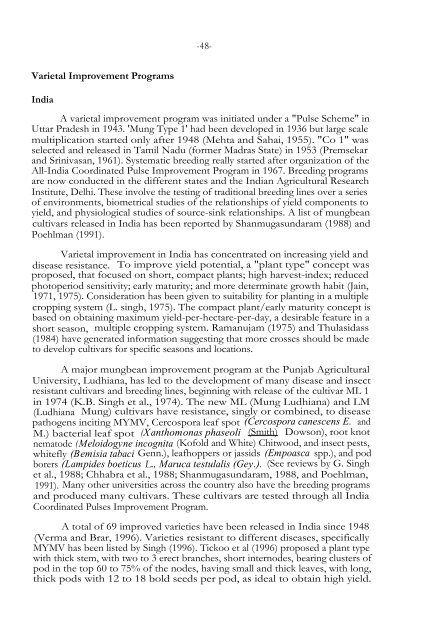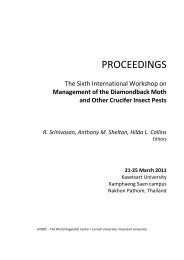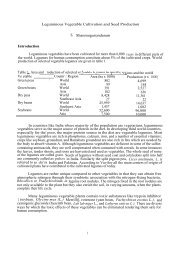MUNGBEAN VARIETAL IMPROVEMENT S. Shanmugasundaram
MUNGBEAN VARIETAL IMPROVEMENT S. Shanmugasundaram
MUNGBEAN VARIETAL IMPROVEMENT S. Shanmugasundaram
You also want an ePaper? Increase the reach of your titles
YUMPU automatically turns print PDFs into web optimized ePapers that Google loves.
-48-<br />
Varietal Improvement Programs<br />
India<br />
A varietal improvement program was initiated under a "Pulse Scheme" in<br />
Uttar Pradesh in 1943. 'Mung Type 1' had been developed in 1936 but large scale<br />
multiplication started only after 1948 (Mehta and Sahai, 1955). "Co 1" was<br />
selected and released in Tamil Nadu (former Madras State) in 1953 (Premsekar<br />
and Srinivasan, 1961). Systematic breeding really started after organization of the<br />
All-India Coordinated Pulse Improvement Program in 1967. Breeding programs<br />
are now conducted in the different states and the Indian Agricultural Research<br />
Institute, Delhi. These involve the testing of traditional breeding lines over a series<br />
of environments, biometrical studies of the relationships of yield components to<br />
yield, and physiological studies of source-sink relationships. A list of mungbean<br />
cultivars released in India has been reported by <strong>Shanmugasundaram</strong> (1988) and<br />
Poehlman (1991).<br />
Varietal improvement in India has concentrated on increasing yield and<br />
disease resistance. To improve yield potential, a "plant type" concept was<br />
proposed, that focused on short, compact plants; high harvest-index; reduced<br />
photoperiod sensitivity; early maturity; and more determinate growth habit (Jain,<br />
1971, 1975). Consideration has been given to suitability for planting in a multiple<br />
cropping system (L. singh, 1975). The compact plant/early maturity concept is<br />
based on obtaining maximum yield-per-hectare-per-day, a desirable feature in a<br />
short season, multiple cropping system. Ramanujam (1975) and Thulasidass<br />
(1984) have generated information suggesting that more crosses should be made<br />
to develop cultivars for specific seasons and locations.<br />
A major mungbean improvement program at the Punjab Agricultural<br />
University, Ludhiana, has led to the development of many disease and insect<br />
resistant cultivars and breeding lines, beginning with release of the cultivar ML 1<br />
in 1974 (K.B. Singh et al., 1974). The new ML (Mung Ludhiana) and LM<br />
(Ludhiana Mung) cultivars have resistance, singly or combined, to disease<br />
pathogens inciting MYMV, Cercospora leaf spot (Cercospora canescens E. and<br />
M.) bacterial leaf spot (Xanthomonas phaseoli (Smith) Dowson), root knot<br />
nematode (Meloidogyne incognita (Kofold and White) Chitwood, and insect pests,<br />
whitefly (Bemisia tabaci Genn.), leafhoppers or jassids (Empoasca spp.), and pod<br />
borers (Lampides boeticus L., Maruca testulalis (Gey.). (See reviews by G. Singh<br />
et al., 1988; Chhabra et al., 1988; <strong>Shanmugasundaram</strong>, 1988, and Poehlman,<br />
1991). Many other universities across the country also have the breeding programs<br />
and produced many cultivars. These cultivars are tested through all India<br />
Coordinated Pulses Improvement Program.<br />
A total of 69 improved varieties have been released in India since 1948<br />
(Verma and Brar, 1996). Varieties resistant to different diseases, specifically<br />
MYMV has been listed by Singh (1996). Tickoo et al (1996) proposed a plant type<br />
with thick stem, with two to 3 erect branches, short internodes, bearing clusters of<br />
pod in the top 60 to 75% of the nodes, having small and thick leaves, with long,<br />
thick pods with 12 to 18 bold seeds per pod, as ideal to obtain high yield.

















